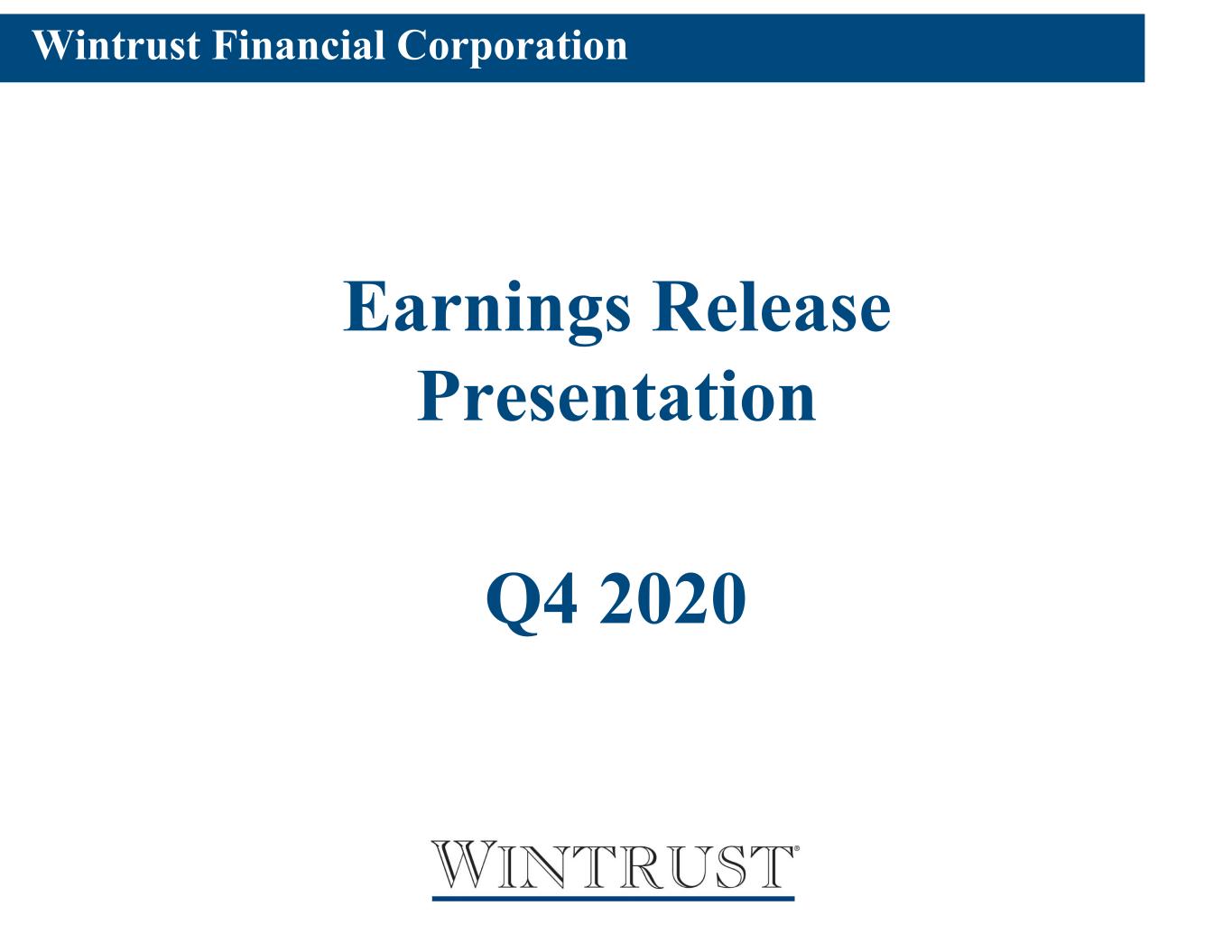
Earnings Release Presentation Q4 2020 Wintrust Financial Corporation

2 ROA3 • Total loans, excluding Paycheck Protection Program ("PPP") loans, increased by $607 million primarily due to growth in commercial loans and life insurance premium finance receivables. • Total deposits increased by $1.2 billion, not withstanding the return of approximately $666 million in wholesale deposits during the fourth quarter of 2020. • Net interest income increased by $3.5 million primarily due to a reduction in the rate on interest- bearing deposits and loan growth. • Provision for credit losses totaled $1.2 million in the fourth quarter of 2020 as compared to $25.0 million in the third quarter of 2020. • Recorded net charge-offs of $10.3 million in the fourth quarter of 2020, as compared to net charge-offs of $9.3 million in the third quarter of 2020. Net charge-offs as a percentage of average total loans, totaled 13 basis points in the fourth quarter of 2020 on an annualized basis compared to 12 basis points on an annualized basis in the third quarter of 2020. • Mortgage banking revenue decreased by $21.7 million to $86.8 million for the fourth quarter of 2020 as compared to $108.5 million in the prior quarter. • Outstanding COVID-19 related loan modifications for customers totaled approximately $345 million or 1.2% of total loans, excluding PPP loans, as of December 31, 2020 as compared to $413 million or 1.4% as of September 30, 2020. • The following items had a $13.2 million unfavorable pre-tax income impact on the fourth quarter of 2020: ◦ Recorded a decrease in the value of mortgage servicing rights related to changes in fair value model assumptions of $5.2 million in the fourth quarter of 2020 as compared to a decline of $3.0 million in the prior quarter. ◦ Accrued $6.6 million of contingent consideration expense in the fourth quarter of 2020 related to the previous acquisition of mortgage operations as compared to $6.3 million in the third quarter of 2020, which was recorded in other non-interest expense. ◦ Recorded an impairment charge of $1.4 million related to the planned closure of 10 bank branches. • Repurchased 974,150 shares of our common stock at a cost of $54.9 million, or an average price of $56.40 per share. $32.1 billion $1.63 Q4 2020 Highlights Other items of note from the Fourth Quarter 2020 Performance Highlights (Q4 2020) $101.2 million Net Income Diluted EPS1 0.92% ROA3 10.30% ROE4 $45.1 billion Total Assets Total Loans $37.1 billion Total Deposits $+1.3 billion Total Assets $(0.1) billion $+1.2 billion Total Loans Total Deposits $(6.1) million Net Income $(0.04) Diluted EPS1 -7 bps2 -36 bps2 ROE4 1.12% 67.53% Net Overhead Ratio Efficiency Ratio (Non-GAAP5) +567 bps2 Efficiency Ratio (Non-GAAP5) +25 bps2 Net Overhead Ratio Fourth Quarter 2020 Highlights as compared to Third Quarter 2020vs. Q3 2020 As of 12/31/2020 vs. 9/30/2020 67.67% Efficiency Ratio (GAAP) +566 bps2 Efficiency Ratio (GAAP) 4 ROE: Return on Average Common Equity 1 Diluted EPS: Net Income Per Common Share - Diluted 3 ROA: Return on Average Assets 5See Non-GAAP reconciliation on pg. 18 2 Bps: Basis Points

3 Earnings Summary Net Income & ROA ($ in Millions) Diluted EPS Key Observations Condensed Income Statement Difference vs. Current QCurrent Q • Pre-Provision Net Revenue increased by $15.5 million compared to the prior quarter and $10.8 million as compared to Q4 2019 • $86.0 $62.8 $21.7 $107.3 $101.2 0.96% 0.69% 0.21% 0.99% 0.92% Net Income ROA Q4 2019 Q1 2020 Q2 2020 Q3 2020 Q4 2020 $1.44 $1.04 $0.34 $1.67 $1.63 Diluted EPS Q4 2019 Q1 2020 Q2 2020 Q3 2020 Q4 2020 Pre-Tax Income, excluding Provision for Credit Losses - 5 Year Trend (Non-GAAP3) ($ in Millions) $365.9 $419.8 $495.0 $534.0 $604.0 Pre-Tax Income, excluding Provision for Credit Losses 2016 2017 2018 2019 2020 3 See Non-GAAP reconciliation on pg. 19 Thousands ($) Q4 2020 Q3 2020 Q4 2019 Net Interest Income $259,397 $3,461 $(2,482) Non-Interest Income $158,361 $(12,232) $46,141 Net Revenue $417,758 $(8,771) $43,659 Non-Interest Expense $281,867 $17,648 $32,276 Pre-Provision Net Revenue $135,891 $(26,419) $11,383 Provision For Credit Losses $1,180 $(23,846) $(6,646) Income Before Taxes $134,711 $(2,573) $18,029 Income Tax Expense1 $33,507 $3,538 $2,789 Net Income $101,204 $(6,111) $15,240 Preferred Stock Dividends2 $6,991 $(3,295) $4,941 Net Income Available to Common Shares $94,213 $(2,816) $10,299 Diluted EPS $1.63 $(0.04) $0.19 ROA 0.92% -7 bps -4 bps ROE 10.30% -36 bps 78 bps 2 Preferred dividends were $7.0 million in Q4 2020. Recorded preferred dividends of $10.3 million in Q3 2020 including dividends declared for Q3 2020 as well as a stub period related to the issuance of preferred stock in Q2 2020. 1 Q3 2020 had a $9.0 million state income tax benefit.

4 $32,136 $342 $(663) $71 $(21) $71 $(196) $(6) $369 $(24) $32,079 9/30/2020 Commercial excl. PPP Commercial PPP Commercial Real Estate Home Equity Residential Real Estate loans for investment Residential mortgage loans, early buy-out eligible loans guaranteed by U.S. Government Agencies Premium Finance Receivables - Commercial Premium Finance Receivables - Life Insurance Consumer & Other 12/31/2020 Loan Portfolio Total Loans ($ in Billions) Total Loans as of 12/31/2020 vs. 9/30/2020 ($ in Millions) Key Observations • Total loans, excluding PPP loans, increased by $607 million primarily due to growth in commercial loans and life insurance premium finance receivables. This growth also included a $71 million net increase in residential real estate loans for investment as the Company decided to allocate a portion of its current and future mortgage production for investment. • In addition, during Q4 2020, the Company exercised its early buyout option on $248 million of eligible loans previously sold to the Government National Mortgage Association ("GNMA") recorded in mortgage loans held-for-sale. • Before the impact of scheduled payments and prepayments, gross commercial and commercial real estate loan pipelines were estimated to be approximately $1.1 billion to $1.3 billion at December 31, 2020. When adjusted for the probability of closing, the pipelines were estimated to be approximately $650 million to $750 million at December 31, 2020. $26.8 $27.8 $31.4 $32.1 $32.1 4.69% 4.52% 3.92% 3.53% 3.51% Total Loans Average Total Loan Yield 12/31/2019 3/31/2020 6/30/2020 9/30/2020 12/31/2020 29% 8% 26% 1% 5% 13% 18% Commercial excl. PPP Commercial PPP Commercial Real Estate Home Equity Residential Real Estate Premium Finance Receivables - Commercial Premium Finance Receivables - Life Insurance Year-over-Year Change $5.3B or 20% Loan Composition (as of 12/31/2020)

5 • Total deposits increased by $1.2 billion from the prior quarter end, which included the return of approximately $666 million in wholesale deposits. • Rate paid on average interest-bearing deposits decreased 10 basis points from the prior quarter. • Non-interest bearing deposits increased $1.3 billion from the prior quarter-end and comprise 32% of total deposits. • The loans to deposits ratio ended the current quarter at 86.5% as compared to 89.7% at prior quarter end. $35,844 $1,339 $55 $(97) $(75) $116 $(89) $37,093 9/30 /202 0 Non -Int eres t Be arin g NO W a nd I nter est Bea ring DD A We alth Ma nag eme nt D epo sits Mo ney Ma rke t Sav ings Tim e C erti fica tes of D epo sit 12/3 1/20 20 Deposit Portfolio Total Deposits ($ in Billions) Total Deposits as of 12/31/2020 vs. 9/30/2020 ($ in Millions)Deposit Composition (as of 12/31/2020) Key Observations $30.1 $31.5 $35.7 $35.8 $37.1 1.33% 1.20% 0.81% 0.61% 0.51% Total Deposits Rate Paid on Average Total Interest-Bearing Deposits 12/31/2019 3/31/2020 6/30/2020 9/30/2020 12/31/2020 32% 9% 11% 25% 10% 13% Non-interest Bearing NOW and Interest-Bearing DDA Wealth Management Deposits Money Market Savings Time Certificates of Deposit Year-over-Year Change $7.0B or 23%
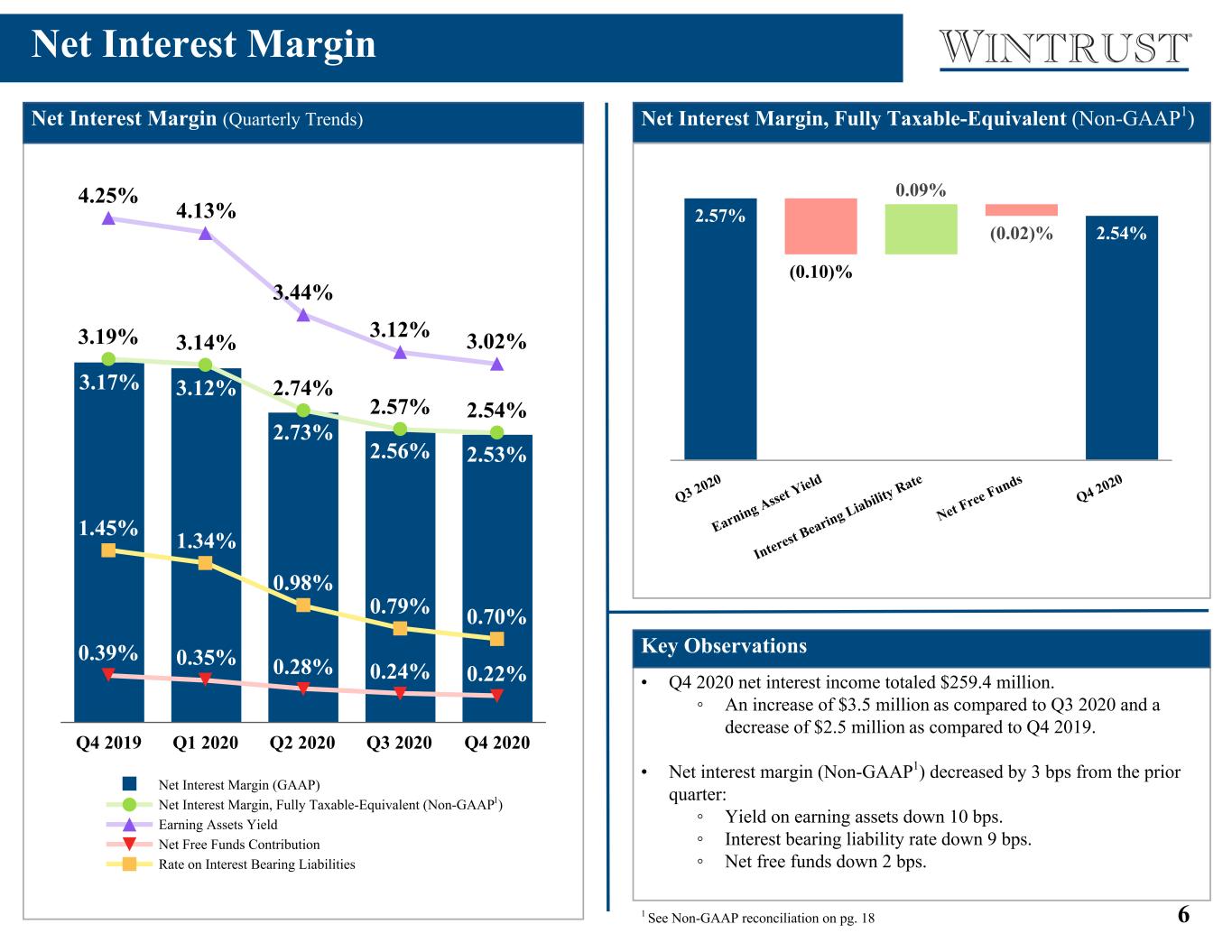
6 3.17% 3.12% 2.73% 2.56% 2.53% 3.19% 3.14% 2.74% 2.57% 2.54% 4.25% 4.13% 3.44% 3.12% 3.02% 0.39% 0.35% 0.28% 0.24% 0.22% 1.45% 1.34% 0.98% 0.79% 0.70% Net Interest Margin (GAAP) Net Interest Margin, Fully Taxable-Equivalent (Non-GAAP ) Earning Assets Yield Net Free Funds Contribution Rate on Interest Bearing Liabilities Q4 2019 Q1 2020 Q2 2020 Q3 2020 Q4 2020 Net Interest Margin • Q4 2020 net interest income totaled $259.4 million. ◦ An increase of $3.5 million as compared to Q3 2020 and a decrease of $2.5 million as compared to Q4 2019. • Net interest margin (Non-GAAP1) decreased by 3 bps from the prior quarter: ◦ Yield on earning assets down 10 bps. ◦ Interest bearing liability rate down 9 bps. ◦ Net free funds down 2 bps. Net Interest Margin, Fully Taxable-Equivalent (Non-GAAP1) Key Observations Net Interest Margin (Quarterly Trends) 2.57% (0.1)% 0.09% (0.02)% 2.54% Q3 202 0 Ear ning Ass et Y ield Inte rest Bea ring Lia bilit y R ate Net Fre e Fu nds Q4 202 0 1 See Non-GAAP reconciliation on pg. 18 1 2.57% (0.10)% 0.09% (0.02)% 2.54% Q3 202 0 Ear ning Ass et Y ield Inte rest Bea ring Lia bilit y R ate Net Fre e Fu nds Q4 202 0 • Q4 2020 net interest income totaled $259.4 million. ◦ A decrease of $3.5 million as compared to Q3 2020 and a decrease of $2.5 million as compared to Q4 2019. • Net interest margin (Non-GAAP1) decreased by 3 bps from the prior quarter: ◦ Earning assets yield down 10 bps. ◦ Interest bearing liability rate down 9 bps. ◦ Net free funds down 2 bps.
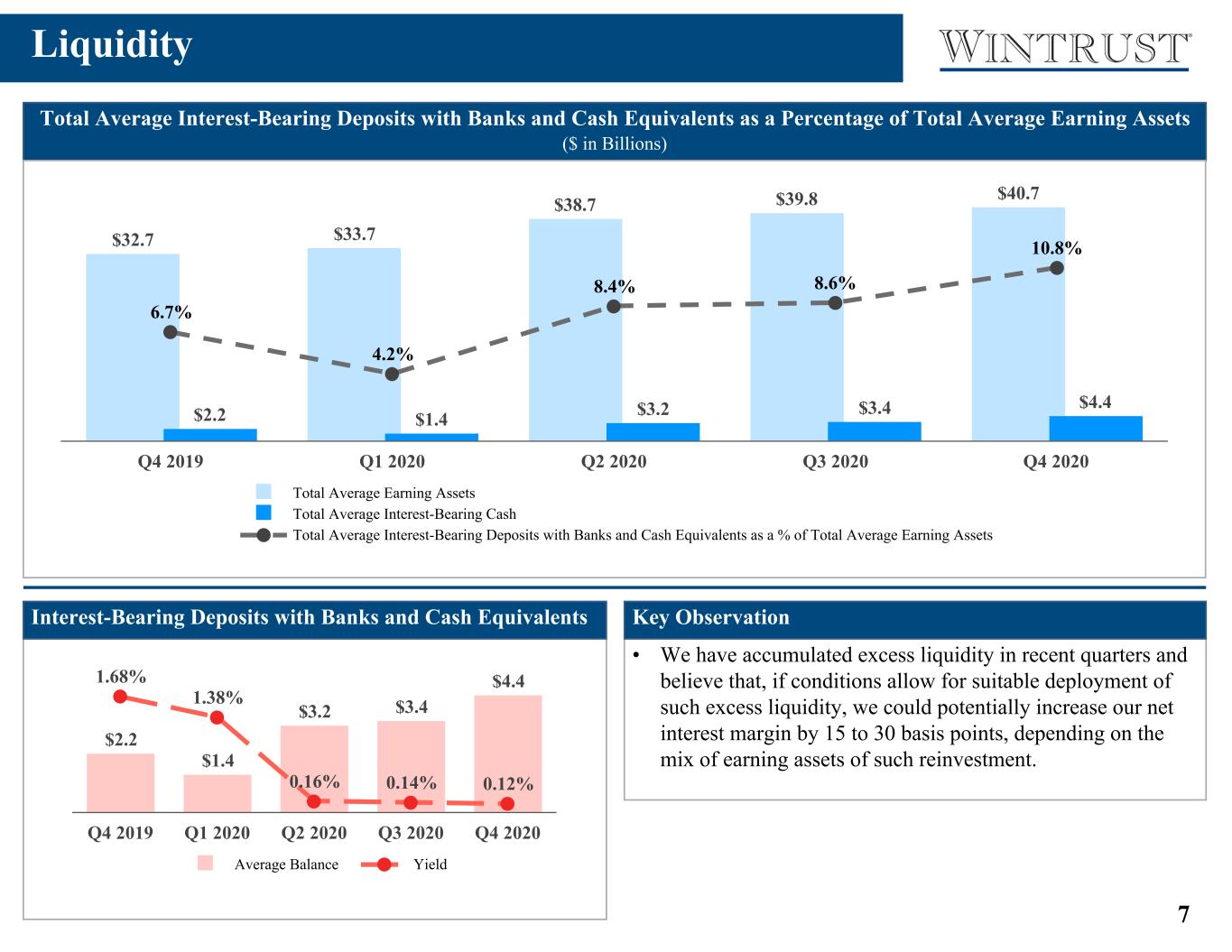
7 Liquidity • We have accumulated excess liquidity in recent quarters and believe that, if conditions allow for suitable deployment of such excess liquidity, we could potentially increase our net interest margin by 15 to 30 basis points, depending on the mix of earning assets of such reinvestment. Key Observation Total Average Interest-Bearing Deposits with Banks and Cash Equivalents as a Percentage of Total Average Earning Assets ($ in Billions) $2.2 $1.4 $3.2 $3.4 $4.41.68% 1.38% 0.16% 0.14% 0.12% Average Balance Yield Q4 2019 Q1 2020 Q2 2020 Q3 2020 Q4 2020 Interest-Bearing Deposits with Banks and Cash Equivalents Equivalents $32.7 $33.7 $38.7 $39.8 $40.7 $2.2 $1.4 $3.2 $3.4 $4.4 6.7% 4.2% 8.4% 8.6% 10.8% Total Average Earning Assets Total Average Interest-Bearing Cash Total Average Interest-Bearing Deposits with Banks and Cash Equivalents as a % of Total Average Earning Assets Q4 2019 Q1 2020 Q2 2020 Q3 2020 Q4 2020
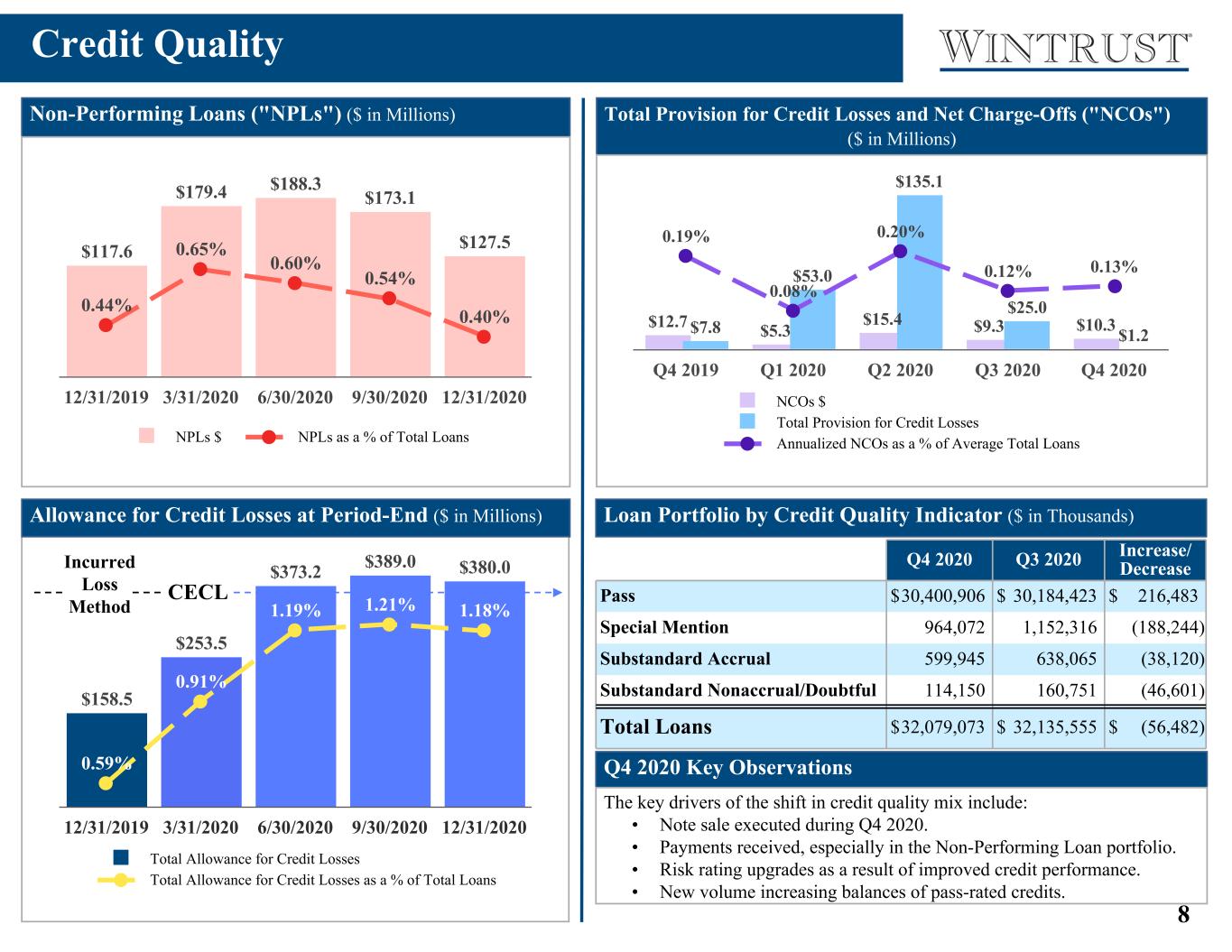
8 $158.5 $253.5 $373.2 $389.0 $380.0 0.59% 0.91% 1.19% 1.21% 1.18% Total Allowance for Credit Losses Total Allowance for Credit Losses as a % of Total Loans 12/31/2019 3/31/2020 6/30/2020 9/30/2020 12/31/2020 Credit Quality • The Company estimates an increase to the allowance for credit losses of approximately 30% to 50% at adoption related to its loan portfolios and related lending commitments. Approximately 80% of the estimated increase is related to: ◦ Additions to existing reserves for unfunded lending-related commitments due to the consideration under CECL of expected utilization by the Company's borrowers over the life of such commitments. ◦ Establishment of reserves for acquired loans which previously considered credit discounts. The Company estimates an insignificant impact at adoption of measuring an allowance for credit losses for other in-scope assets (e.g. held-to-maturity debt securities). Allowance for Credit Losses at Period-End ($ in Millions) Non-Performing Loans ("NPLs") ($ in Millions) Total Provision for Credit Losses and Net Charge-Offs ("NCOs") ($ in Millions) Loan Portfolio by Credit Quality Indicator ($ in Thousands) $117.6 $179.4 $188.3 $173.1 $127.5 0.44% 0.65% 0.60% 0.54% 0.40% NPLs $ NPLs as a % of Total Loans 12/31/2019 3/31/2020 6/30/2020 9/30/2020 12/31/2020 $12.7 $5.3 $15.4 $9.3 $10.3$7.8 $53.0 $135.1 $25.0 $1.2 0.19% 0.08% 0.20% 0.12% 0.13% NCOs $ Total Provision for Credit Losses Annualized NCOs as a % of Average Total Loans Q4 2019 Q1 2020 Q2 2020 Q3 2020 Q4 2020 $7.8 $53.0 $135.1 $25.0 $1.2 161.87% 9.98% 11.41% 37.10% Total Provision for Credit Losses Net Charge-Offs as a % of the Provision for Credit Losses 12/31/2019 3/31/2020 6/30/2020 9/30/2020 12/31/2020 $7.8 $53 $135.1 $0 $0 $— $— $— $— $—$7.8 $53.0 $135.1 161.9% 10.0% 11.4% 37.1% 876.0% Provision for credit losses - PCD Provision for credit losses - non PCD Net charge-offs as a percentage of the provision for credit losses Q4 2019 Q1 2020 Q2 2020 Q3 2020 Q4 2020 Incurred Loss Method CECL Incurred Loss Method CECL Q4 2020 Q3 2020 Increase/Decrease Pass $ 30,400,906 $ 30,184,423 $ 216,483 Special Mention 964,072 1,152,316 (188,244) Substandard Accrual 599,945 638,065 (38,120) Substandard Nonaccrual/Doubtful 114,150 160,751 (46,601) Total Loans $ 32,079,073 $ 32,135,555 $ (56,482) Q4 2020 Key Observations The key drivers of the shift in credit quality mix include: • Note sale executed during Q4 2020. • Payments received, especially in the Non-Performing Loan portfolio. • Risk rating upgrades as a result of improved credit performance. • New volume increasing balances of pass-rated credits.
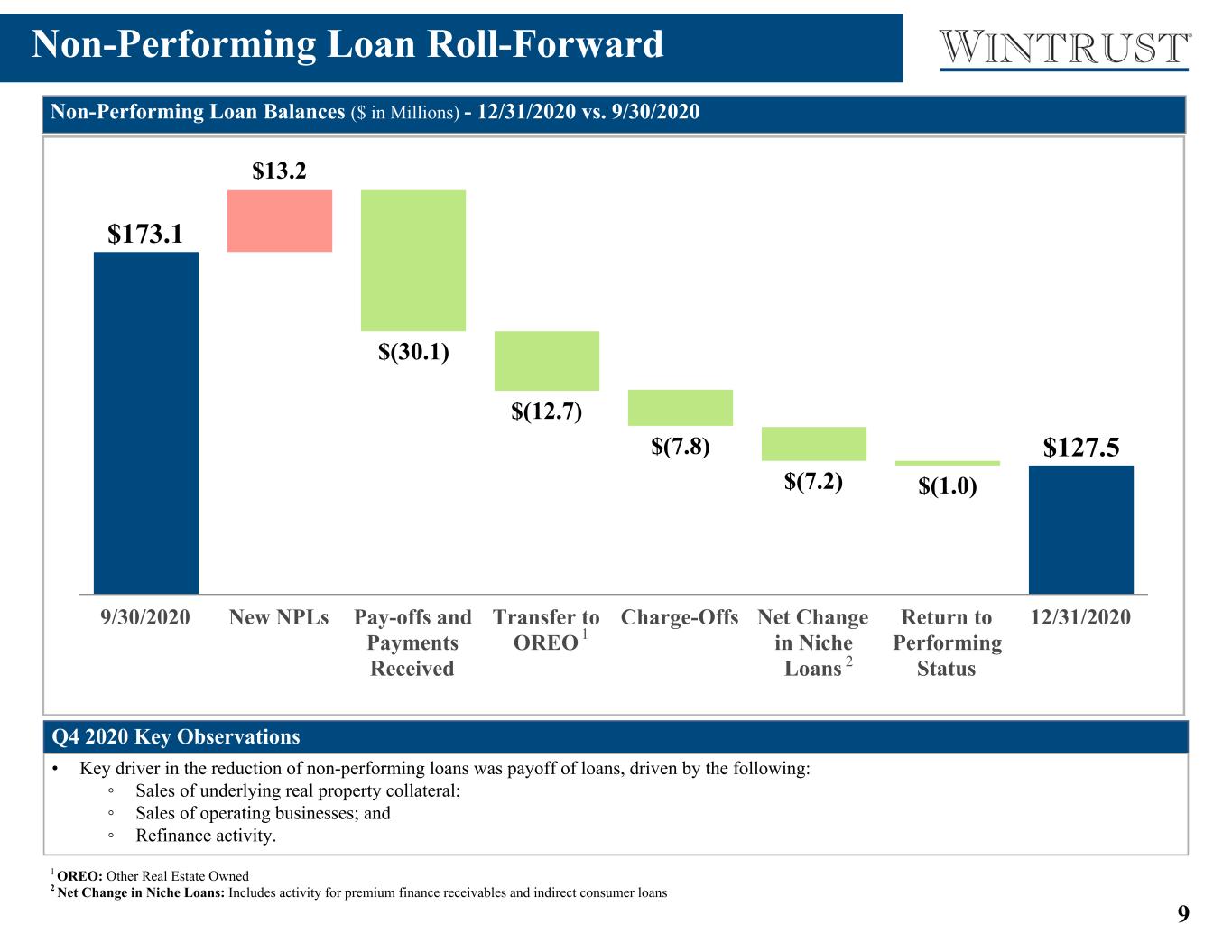
9 Non-Performing Loan Roll-Forward $173.1 $13.2 $(30.1) $(12.7) $(7.8) $(7.2) $(1.0) $127.5 9/30/2020 New NPLs Pay-offs and Payments Received Transfer to OREO Charge-Offs Net Change in Niche Loans Return to Performing Status 12/31/2020 Non-Performing Loan Balances ($ in Millions) - 12/31/2020 vs. 9/30/2020 Q4 2020 Key Observations • Key driver in the reduction of non-performing loans was payoff of loans, driven by the following: ◦ Sales of underlying real property collateral; ◦ Sales of operating businesses; and ◦ Refinance activity. 1 OREO: Other Real Estate Owned 1 2 2 Net Change in Niche Loans: Includes activity for premium finance receivables and indirect consumer loans

10 $388,971 $(21,448) $12,446 $379,969 9/30/2020 12/31/2020 • Stabilizing macroeconomic indicators and market conditions • Continuing governmental monetary and fiscal support • Substantial liquidity in the market • Future expectations regarding current and former COVID-19 loan modifications • Low exposure to industries with the highest risk factors • High touch relationships with commercial and consumer borrowers • Economic Inputs ◦ Baa Credit Spread ◦ Commercial Real-Estate Price Index ◦ GDP ◦ Dow Jones Total Stock Market Index • Portfolio Characteristics ◦ Risk Ratings ◦ Life of Loan Credit Quality - CECL Allowance for Credit Losses ($ in Thousands) - 12/31/2020 vs. 9/30/2020 Key Observations • CECL Day 1 transition adjustment • Includes ACL for loans and leases, off- balance sheet credit exposures and debt securities • New volume and run-off • Changes in credit quality • Aging of existing portfolio • Shifts in segmentation mix • Changes in specific reserves • Model imprecision • Net charge-offs • Changes due to macroeconomic conditions Day 1 Adjustment Portfolio Changes Economic Factors • Baa Corporate credit spread generally narrows in the 8-Quarter Reasonable and Supportable ("R&S") time period. • Commercial Real Estate Price Index declines through Q1 2022 and then remains relatively flat for the remainder of the R&S time period. • Real GDP growth rate stays above potential GDP growth rate of 1.44% in 2021 and 1.7% in 2022. • Dow Jones U.S. Total Stock Market Index remains volatile but increases throughout the R&S time period. • The amount of Allowance for Credit Losses was negatively impacted due to ongoing concerns related to COVID-19 primarily related to the Commercial Real Estate Price Index. Macroeconomic Scenario Key Model Inputs Qualitative Considerations
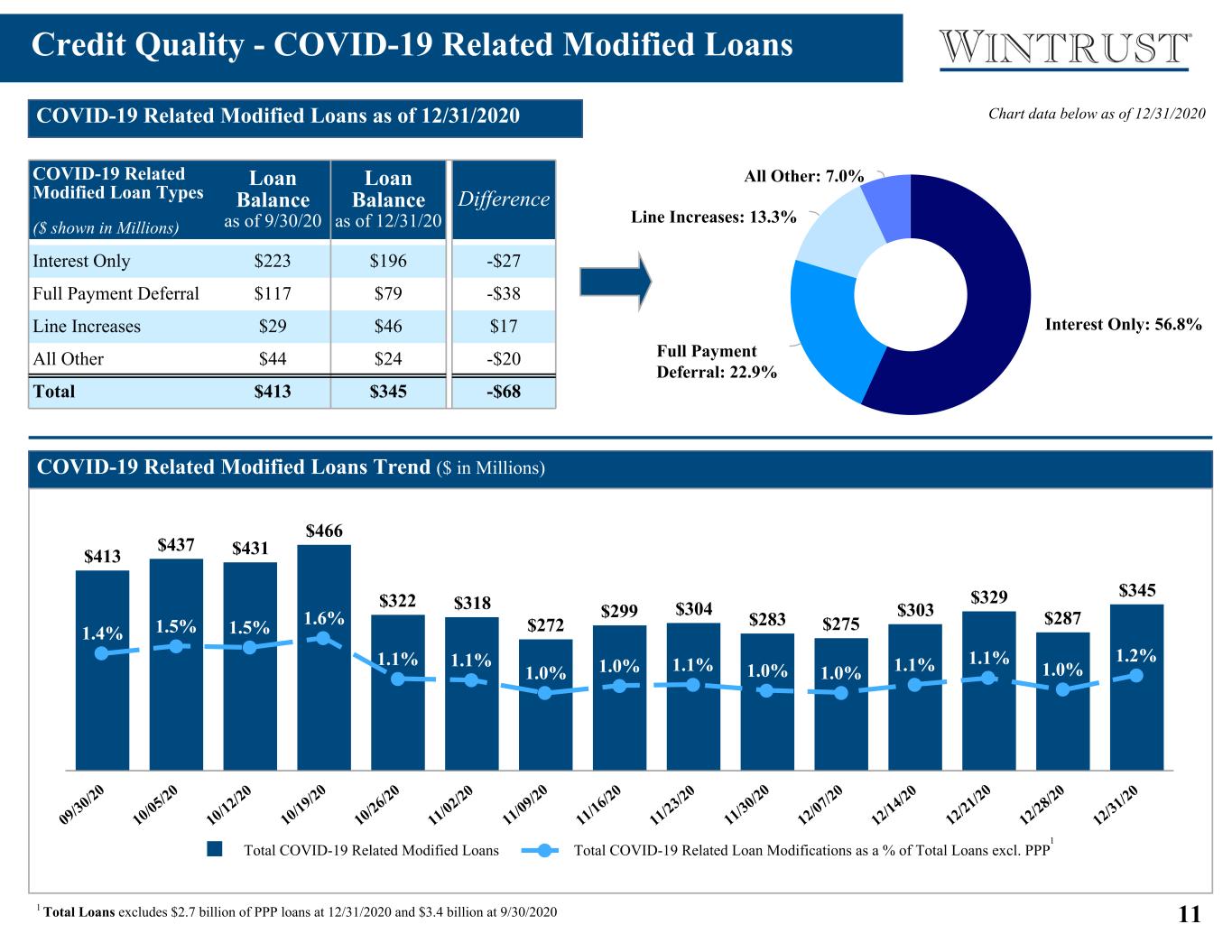
11 Retail: 40.2% Franchise: 59.8% Credit Quality - COVID-19 Related Modified Loans Interest Only: 56.8% Full Payment Deferral: 22.9% Line Increases: 13.3% All Other: 7.0% COVID-19 Related Modified Loans as of 12/31/2020 COVID-19 Related Modified Loan Types ($ shown in Millions) Loan Balance as of 9/30/20 Loan Balance as of 12/31/20 Difference Interest Only $223 $196 -$27 Full Payment Deferral $117 $79 -$38 Line Increases $29 $46 $17 All Other $44 $24 -$20 Total $413 $345 -$68 COVID-19 Related Modified Loans Trend ($ in Millions) • COVID-19 related modified loan balances decreased $1.3 billion or 77.4% in the fourth quarter of 2020 as compared to the prior quarter. • Full Payment Deferral loans make up 11.2% of COVID-19 related modified loans as of September 30, 2020, down notably from the 39.3% as of June 30, 2020. • Full Payment Deferral COVID-19 related modified loans had the single greatest drop of all the categories at 85.8% in the fourth quarter of 2020 as compared to the prior quarter. 1 Excludes Premium Finance modifications of $12MM as of June 30, 2020 and $21MM as of September 30, 2020. Chart data below as of 12/31/2020 Commercial Real Estate Retail has COVID-19 related modified loans as a percentage of its portfolio balance of 2.2%. Commercial Real Estate Retail comprises 4.1% of the Total Loan Portfolio excluding PPP Loans. $413 $437 $431 $466 $322 $318 $272 $299 $304 $283 $275 $303 $329 $287 $345 1.4% 1.5% 1.5% 1.6% 1.1% 1.1% 1.0% 1.0% 1.1% 1.0% 1.0% 1.1% 1.1% 1.0% 1.2% Total COVID-19 Related Modified Loans Total COVID-19 Related Loan Modifications as a % of Total Loans excl. PPP 09 /30 /20 10 /05 /20 10 /12 /20 10 /19 /20 10 /26 /20 11 /02 /20 11 /09 /20 11 /16 /20 11 /23 /20 11 /30 /20 12 /07 /20 12 /14 /20 12 /21 /20 12 /28 /20 12 /31 /20 1 Total Loans excludes PPP loans 1 1 Total Loans excludes $2.7 billion of PPP loans at 12/31/2020 and $3.4 billion at 9/30/2020

12 1 PCD: Purchased Credit Deteriorated loans Commercial and Commercial Real Estate Portfolio Loan Portfolio Mix, Growth, and COVID-19 Related Modified Loans as of 12/31/2020 and 9/30/2020 (Commercial and Commercial Real Estate Portfolio) As of As of Increase/ COVID-19 Related Modified Loans as of 12/31/2020 COVID-19 Related Modified Loans as a % of Total Balance as of 12/31/2020(Dollars in thousands) 12/31/2020 9/30/2020 (Decrease) Commercial: Commercial and industrial $ 4,639,597 $ 4,540,576 $ 99,021 $ 133,033 2.9 % PPP 2,715,921 3,379,013 (663,092) — — % Franchise 1,023,027 964,150 58,877 38,490 3.8 % Mortgage warehouse lines of credit 567,389 503,371 64,018 — — % Community Advantage - homeowner associations 265,082 252,638 12,444 — — % Asset-based lending 721,666 705,588 16,078 3,954 0.5 % Municipal 474,103 477,343 (3,240) — — % Leases 1,288,374 1,214,988 73,386 20,173 1.6 % Other 251,490 224,697 26,793 — — % Commercial, industrial, and other - PCD1 9,318 14,635 (5,317) 270 2.9 % Total Commercial: $ 11,955,967 $ 12,276,999 $ (321,032) $ 195,920 1.6 % Commercial real-estate: Residential construction $ 86,167 $ 91,836 $ (5,669) $ — — % Commercial construction 1,039,982 998,144 41,838 19,806 1.9 % Land 237,073 222,109 14,964 4,067 1.7 % Office 1,125,906 1,151,425 (25,519) 11,172 1.0 % Industrial 1,120,700 1,108,353 12,347 7,269 0.6 % Retail 1,192,759 1,137,889 54,870 25,890 2.2 % Multi-family 1,641,216 1,588,037 53,179 4,513 0.3 % Mixed use and other 1,952,569 1,995,711 (43,142) 62,774 3.2 % Commercial real-estate - PCD1 97,760 129,638 (31,878) 831 0.9 % Total Commercial real-estate: $ 8,494,132 $ 8,423,142 $ 70,990 $ 136,322 1.6 % Total Commercial and Commercial real-estate $ 20,450,099 $ 20,700,141 $ (250,042) $ 332,242 1.6 %
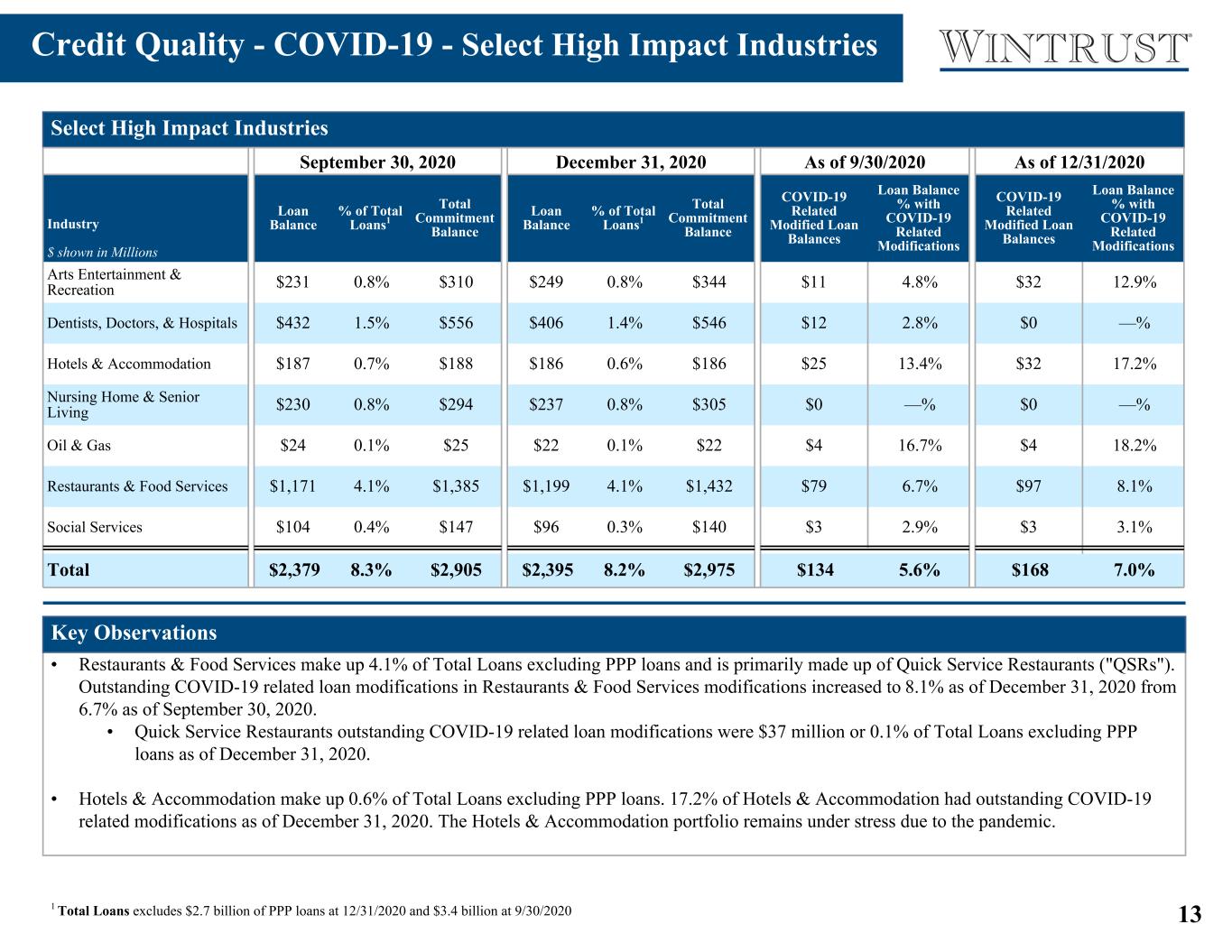
13 • Restaurants & Food Services make up 4.1% of Total Loans excluding PPP loans and is primarily made up of Quick Service Restaurants ("QSRs"). Outstanding COVID-19 related loan modifications in Restaurants & Food Services modifications increased to 8.1% as of December 31, 2020 from 6.7% as of September 30, 2020. • Quick Service Restaurants outstanding COVID-19 related loan modifications were $37 million or 0.1% of Total Loans excluding PPP loans as of December 31, 2020. • Hotels & Accommodation make up 0.6% of Total Loans excluding PPP loans. 17.2% of Hotels & Accommodation had outstanding COVID-19 related modifications as of December 31, 2020. The Hotels & Accommodation portfolio remains under stress due to the pandemic. Key Observations Select High Impact Industries 8.3% Credit Quality - COVID-19 - Select High Impact Industries Key Observations Other Loans 91.7% Total loans of $32.1 billion 1 Total Loans excludes $2.7 billion of PPP loans at 12/31/2020 and $3.4 billion at 9/30/2020 Total Loan Mix1 as of 9/30/2020: Select High Impact Industries Select High Impact Industries September 30, 2020 December 31, 2020 As of 9/30/2020 As of 12/31/2020 Industry $ shown in Millions Loan Balance % of Total Loans1 Total Commitment Balance Loan Balance % of Total Loans1 Total Commitment Balance COVID-19 Related Modified Loan Balances Loan Balance % with COVID-19 Related Modifications COVID-19 Related Modified Loan Balances Loan Balance % with COVID-19 Related Modifications Arts Entertainment & Recreation $231 0.8% $310 $249 0.8% $344 $11 4.8% $32 12.9% Dentists, Doctors, & Hospitals $432 1.5% $556 $406 1.4% $546 $12 2.8% $0 —% Hotels & Accommodation $187 0.7% $188 $186 0.6% $186 $25 13.4% $32 17.2% Nursing Home & Senior Living $230 0.8% $294 $237 0.8% $305 $0 —% $0 —% Oil & Gas $24 0.1% $25 $22 0.1% $22 $4 16.7% $4 18.2% Restaurants & Food Services $1,171 4.1% $1,385 $1,199 4.1% $1,432 $79 6.7% $97 8.1% Social Services $104 0.4% $147 $96 0.3% $140 $3 2.9% $3 3.1% Total $2,379 8.3% $2,905 $2,395 8.2% $2,975 $134 5.6% $168 7.0%

14 Non-Interest Income ($ in Millions) $112.2 $113.2 $162.0 $170.6 $158.4 $25.0 $25.9 $22.6 $25.0 $26.8 $47.9 $48.3 $102.3 $108.5 $86.8$12.5 $12.0 $11.8 $11.7 $12.1 $11.0 $11.3 $10.4 $11.5 $11.8 $15.8 $15.7 $14.9 $13.9 $20.9 Wealth Management Mortgage Banking Operating Lease Income, net Service Charges on Deposits Other Q4 2019 Q1 2020 Q2 2020 Q3 2020 Q4 2020 Non-Interest Income Wealth Management Revenue ($ in Millions) • Non-interest income totaled $158.4 million: ◦ A decrease of $12.2 million as compared to Q3 2020 and an increase of $46.1 million as compared to Q4 2019. • Mortgage banking revenue decreased by $21.7 million in the fourth quarter of 2020 as compared to the third quarter of 2020. ◦ Loans originated for sale were $2.4 billion at the end of the fourth quarter of 2020, an increase of $124.7 million as compared to the third quarter of 2020. • Wealth management income increased $1.8 million as compared to Q3 2020 primarily due to increased trust and asset management fees and brokerage commissions. Key Observations 1 Other NII - includes Interest Rate Swap Fees, BOLI, Administrative Services, FX Remeasurement Gains/(Losses), Early Pay-Offs of Capital Leases, Gains/(losses) on investment securities, net, Fees from covered call options, Trading gains/(losses), net and Miscellaneous. 1 $25.0 $25.9 $22.6 $25.0 $26.8 $20.1 $20.6 $18.5 $20.4 $22.1 $4.9 $5.3 $4.1 $4.6 $4.7 $27.6 $25.0 $27.0 $28.2 $30.1 Trust and Asset Management Brokerage Assets Under Administration ($ in Billions) Q4 2019 Q1 2020 Q2 2020 Q3 2020 Q4 2020 Operating Lease Income, Net ($ in Millions) $12.5 $12.0 $11.8 $11.7 $12.1 $231.2 $207.1 $237.0 $230.4 $242.4 Operating Lease Income, Net Lease Investments, Net (Period-End Balance) Q4 2019 Q1 2020 Q2 2020 Q3 2020 Q4 2020

15 $47.938 $(8.7)$(7.9)$(9.0) $2.3 $(14.6)$(8.0)$(3.0)$(5.2) $34.7 $49.3 $93.4$94.1$70.9 $3.7 $7.0 $(104.1)$(77.0) $14.5 $9.4 $(0.5) MSR - Payoffs/Paydowns MSR - Change in Fair Value Model Assumptions Production Revenue Servicing Income & Other MSR Capitalization MSR Hedging Gains (Losses) Q4 2019 Q1 2020 Q2 2020 Q3 2020 Q4 2020 Mortgage Banking Production Revenue ($ in Millions) MSR1 Value and Loans Serviced for Others ($ in Millions) Originations for Sale ($ in Millions) Key Observations • Loans originated for sale in the fourth quarter of 2020 totaled $2.4 billion as compared to $2.2 billion in the prior quarter. • Production margin declined to 3.01% in the fourth quarter of 2020 as compared to 4.23% in the third quarter of 2020. ◦ Production revenue decreased in the fourth quarter of 2020 due to an approximately $500 million decline in outstanding mortgage pipeline as of December 31, 2020 as compared to prior quarter end. ▪ This decline was partially due to the Company increasing originations allocated for investment by approximately $200 million in an effort to increase earning assets on the balance sheet. % of MSRs to Loans Serviced for Others Q4 2019 Q1 2020 Q2 2020 Q3 2020 Q4 2020 1.04% 0.88% 0.84% 0.86% 0.85% 1 MSR: Mortgage Servicing Right LOGIC IN MORTGAGE BANKING REVENUE NEEDS TO BE MODIFIED Mortgage banking production revenue decreased by $23.3 million as mortgage originations for sale totaled $2.4 billion in the fourth quarter of 2020 as compared to $2.2 billion in the third quarter of 2020. $34.6 $49.3 $93.4 $94.1 $70.9 2.78% 4.06% 4.23% 4.23% 3.01% Production Revenue Production Margin Q4 2019 Q1 2020 Q2 2020 Q3 2020 Q4 2020 $85.6 $73.5 $77.2 $86.9 $92.1 $8,243 $8,315 $9,188 $10,140 $10,833 MSRs, at fair value Loans Serviced for Others Q4 2019 Q1 2020 Q2 2020 Q3 2020 Q4 2020 $1,245 $1,216 $2,211 $2,227 $2,351 $782 $773 $1,589 $1,591 $1,757$4 $459 $443 $622 $636 $594 Retail Originations Correspondent Originations Veterans First Originations Q4 2019 Q1 2020 Q2 2020 Q3 2020 Q4 2020

16 $249.6 $234.6 $259.4 $264.2 $281.9 $145.9 $136.8 $154.2 $164.0 $171.1 $14.5 $14.8 $15.8 $17.3 $20.6$17.1 $17.5 $16.9 $15.8 $19.7 $12.5 $10.9 $7.7 $7.9 $9.9 $9.8 $9.3 $9.3 $9.4 $9.9 $7.7 $6.7 $7.7 $6.5 $6.5 $7.6 $8.4 $10.4 $5.7 $5.7$34.5 $30.2 $37.4 $37.6 $38.5 Salaries and Employee Benefits Equipment Occupancy, net Advertising and Marketing Operating Lease Equipment Professional Fees Data Processing Other Q4 2019 Q1 2020 Q2 2020 Q3 2020 Q4 2020 1.53% 1.33% 0.93% 0.87% 1.12% 66.56% 61.67% 60.97% 61.86% 67.53% Net Overhead Ratio Efficiency Ratio (Non-GAAP ) Q4 2019 Q1 2020 Q2 2020 Q3 2020 Q4 2020 Non-Interest Expense Trending Non-Interest Expense ($ in Millions) Q4 2020 Key Observations • Salary and employee benefits increase comprised of: ◦ $3.9 million increase in commissions and incentive compensation. ◦ $3.7 million increase in salaries. ◦ $0.5 million decrease in employee benefits expense. • Occupancy expense increase of $3.9 million relates primarily to an impairment charge of $1.4 million related to the planned closure of 10 bank branches, increased real estate tax assessment estimates and a higher level of utility charges. • Equipment increase of $3.3 million relates primarily due to increased software licensing expenses. 1 Other NIE - includes amortization of other intangible assets, FDIC insurance, OREO expense, net, Commissions (3rd Party Brokers), Postage and Miscellaneous Non-Interest Expense - Current Quarter vs. Prior Quarter ($ in Millions) $264.2 $7.1 $3.3 $3.9 $2.0 $1.4 $281.9 Q3 2020 Salaries and Employee Benefits Equipment Occupancy, net Advertising and marketing All Other Expenses Q4 2020 1 Expense Management Ratios 2 3 2 Net Overhead Ratio - The net overhead ratio is calculated by netting total non- interest expense and total non-interest income, annualizing this amount, and dividing by that period's average total assets. A lower ratio indicates a higher degree of efficiency. 3 See Non-GAAP reconciliation on pg.18
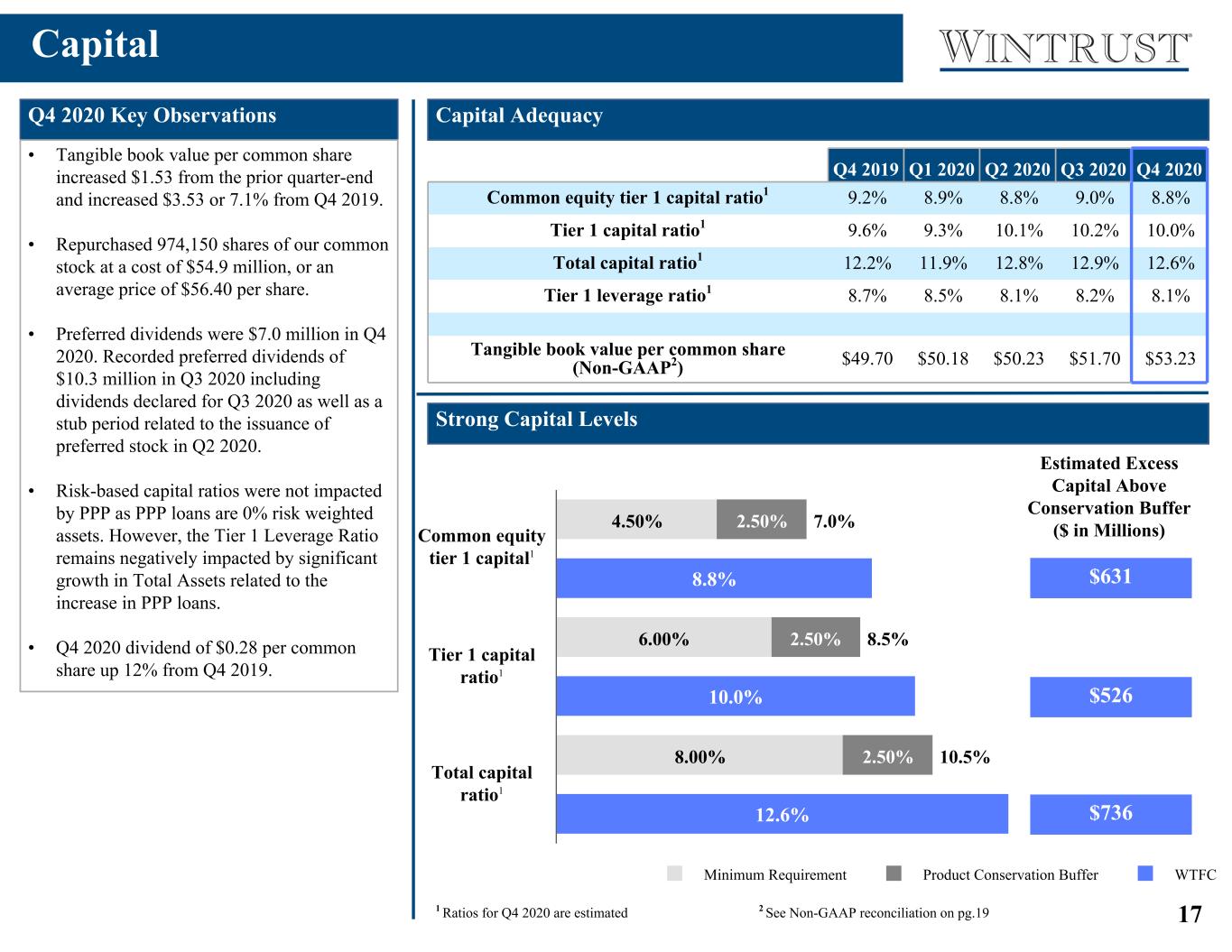
17 7.0% 8.5% 10.5% 4.50% 6.00% 8.00% 2.50% 2.50% 2.50% 8.8% 10.0% 12.6% Minimum Requirement Product Conservation Buffer WTFC Capital Q4 2020 Key Observations Strong Capital Levels • Tangible book value per common share increased $1.53 from the prior quarter-end and increased $3.53 or 7.1% from Q4 2019. • Repurchased 974,150 shares of our common stock at a cost of $54.9 million, or an average price of $56.40 per share. • Preferred dividends were $7.0 million in Q4 2020. Recorded preferred dividends of $10.3 million in Q3 2020 including dividends declared for Q3 2020 as well as a stub period related to the issuance of preferred stock in Q2 2020. • Risk-based capital ratios were not impacted by PPP as PPP loans are 0% risk weighted assets. However, the Tier 1 Leverage Ratio remains negatively impacted by significant growth in Total Assets related to the increase in PPP loans. • Q4 2020 dividend of $0.28 per common share up 12% from Q4 2019. 2 See Non-GAAP reconciliation on pg.19 Capital Adequacy Q4 2019 Q1 2020 Q2 2020 Q3 2020 Q4 2020 Common equity tier 1 capital ratio1 9.2% 8.9% 8.8% 9.0% 8.8% Tier 1 capital ratio1 9.6% 9.3% 10.1% 10.2% 10.0% Total capital ratio1 12.2% 11.9% 12.8% 12.9% 12.6% Tier 1 leverage ratio1 8.7% 8.5% 8.1% 8.2% 8.1% Tangible book value per common share (Non-GAAP2) $49.70 $50.18 $50.23 $51.70 $53.23 Estimated Excess Capital Above Conservation Buffer ($ in Millions)Common equity tier 1 capital1 Tier 1 capital ratio1 Total capital ratio1 $631 $526 $736 1 Ratios for Q4 2020 are estimated

18 Three Months Ended Years Ended Reconciliation of Non-GAAP Net Interest Margin and Efficiency Ratio ($ in Thousands): December 31, September 30, June 30, March 31, December 31, December 31, December 31, 2020 2020 2020 2020 2019 2020 2019 (A) Interest Income (GAAP) $ 307,981 $ 311,156 $ 329,816 $ 344,067 $ 349,731 $ 1,293,020 $ 1,385,142 Taxable-equivalent adjustment: - Loans 324 481 576 860 892 2,241 3,935 - Liquidity Management Assets 530 546 538 551 573 2,165 2,280 - Other Earning Assets 3 1 3 2 1 9 9 (B) Interest Income (non-GAAP) $ 308,838 $ 312,184 $ 330,933 $ 345,480 $ 351,197 $ 1,297,435 $ 1,391,366 (C) Interest Expense (GAAP) $ 48,584 $ 55,220 $ 66,685 $ 82,624 $ 87,852 $ 253,113 $ 330,223 (D) Net Interest Income (GAAP) (A minus C) $ 259,397 $ 255,936 $ 263,131 $ 261,443 $ 261,879 $ 1,039,907 $ 1,054,919 (E) Net Interest Income (non-GAAP) (B minus C) $ 260,254 $ 256,964 $ 264,248 $ 262,856 $ 263,345 $ 1,044,322 $ 1,061,143 Net interest margin (GAAP) 2.53% 2.56% 2.73% 3.12% 3.17% 2.72% 3.45% Net interest margin, fully taxable-equivalent (non-GAAP) 2.54% 2.57% 2.74% 3.14% 3.19% 2.73% 3.47% (F) Non-interest income $ 158,361 $ 170,593 $ 161,993 $ 113,242 $ 112,220 $ 604,189 $ 407,172 (G) Gains (losses) on investment securities, net 1,214 411 808 (4,359) 587 (1,926) 3,525 (H) Non-interest expense 281,867 264,219 259,368 234,641 249,591 1,040,095 928,126 Efficiency ratio (H/(D+F-G)) 67.67% 62.01% 61.13% 61.90% 66.82% 63.19% 63.63% Efficiency ratio (non-GAAP) (H/(E+F-G)) 67.53% 61.86% 60.97% 61.67% 66.56% 63.02% 63.36% Non-GAAP Reconciliation The accounting and reporting policies of Wintrust conform to generally accepted accounting principles (“GAAP”) in the United States and prevailing practices in the banking industry. However, certain non- GAAP performance measures and ratios are used by management to evaluate and measure the Company’s performance. Management believes that these measures and ratios provide users of the Company’s financial information a more meaningful view of the performance of the Company's interest-earning assets and interest-bearing liabilities and of the Company’s operating efficiency. Other financial holding companies may define or calculate these measures and ratios differently.

19 Three Months Ended Reconciliation of Non-GAAP Tangible Common Equity ($'s and Shares in Thousands): December 31, September 30, June 30, March 31, December 31, 2020 2020 2020 2020 2019 Total shareholders’ equity (GAAP) $ 4,115,995 $ 4,074,089 $ 3,990,218 $ 3,700,393 $ 3,691,250 Less: Non-convertible preferred stock (GAAP) (412,500) (412,500) (412,500) (125,000) (125,000) Less: Intangible assets (GAAP) (681,747) (683,314) (685,581) (687,626) (692,277) (I) Total tangible common shareholders’ equity (non- GAAP) $ 3,021,748 $ 2,978,275 $ 2,892,137 $ 2,887,767 $ 2,873,973 Reconciliation of Non-GAAP Tangible Book Value per Common Share ($'s and Shares in Thousands): Total shareholders’ equity $ 4,115,995 $ 4,074,089 $ 3,990,218 $ 3,700,393 $ 3,691,250 Less: Preferred stock (412,500) (412,500) (412,500) (125,000) (125,000) (L) Total common equity $ 3,703,495 $ 3,661,589 $ 3,577,718 $ 3,575,393 $ 3,566,250 (M) Actual common shares outstanding 56,770 57,602 57,574 57,545 57,822 Book value per common share (L/M) $65.24 $63.57 $62.14 $62.13 $61.68 Tangible book value per common share (non-GAAP) (I/M) $53.23 $51.70 $50.23 $50.18 $49.70 Non-GAAP Reconciliation The accounting and reporting policies of Wintrust conform to generally accepted accounting principles (“GAAP”) in the United States and prevailing practices in the banking industry. However, certain non- GAAP performance measures and ratios are used by management to evaluate and measure the Company’s performance. Management believes that these measures and ratios provide users of the Company’s financial information a more meaningful view of the performance of the Company's interest-earning assets and interest-bearing liabilities and of the Company’s operating efficiency. Other financial holding companies may define or calculate these measures and ratios differently. Years Ended Reconciliation of Non-GAAP Pre-Tax, Pre-Provision Income ($ in Thousands): December 31, December 31, December 31, December 31, December 31, 2020 2019 2018 2017 2016 Income before taxes $ 389,781 $ 480,101 $ 460,133 $ 389,997 $ 331,854 Add: Provision for credit losses 214,220 53,864 34,832 29,768 34,084 Pre-tax income, excluding provision for credit losses (non- GAAP) $ 604,001 $ 533,965 $ 494,965 $ 419,765 $ 365,938
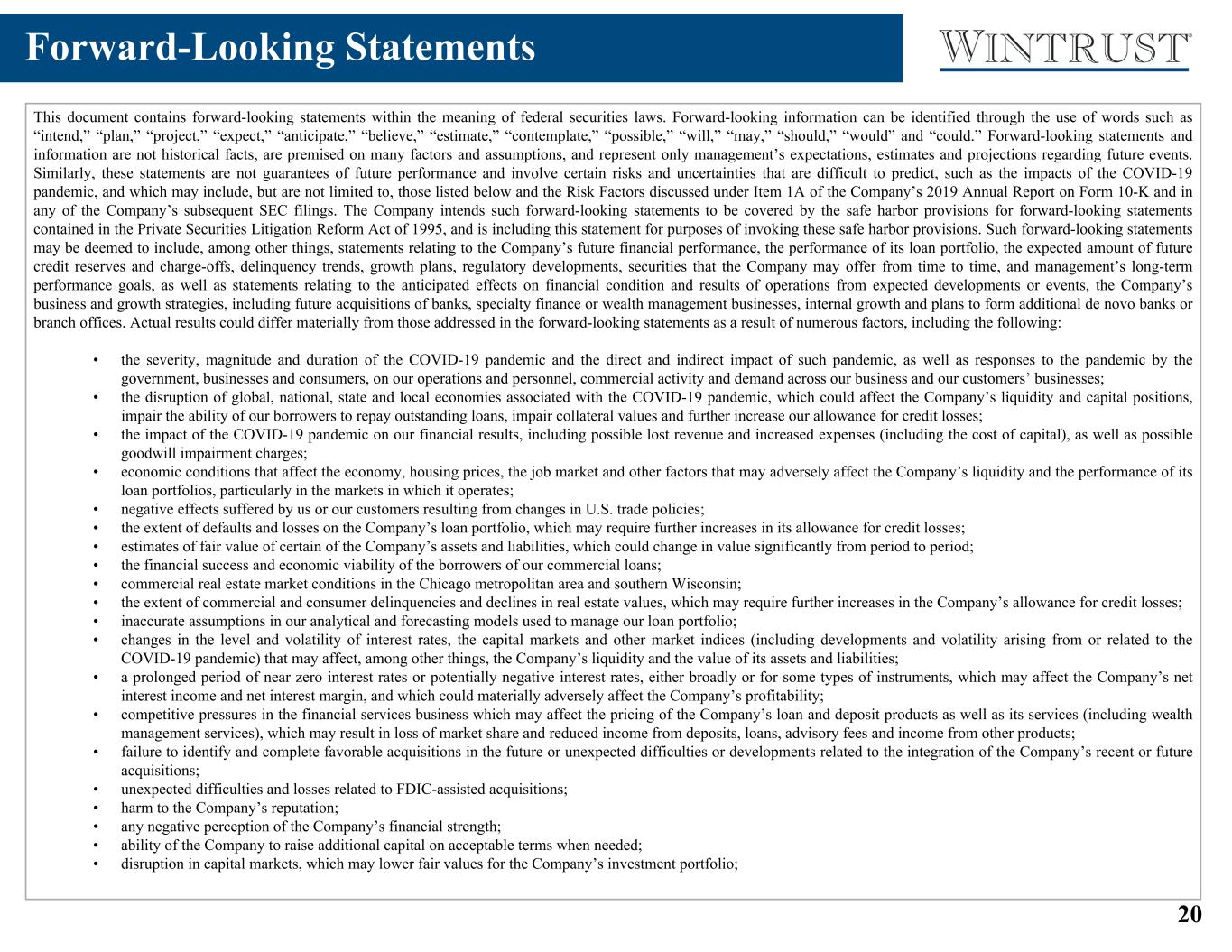
20 This document contains forward-looking statements within the meaning of federal securities laws. Forward-looking information can be identified through the use of words such as “intend,” “plan,” “project,” “expect,” “anticipate,” “believe,” “estimate,” “contemplate,” “possible,” “will,” “may,” “should,” “would” and “could.” Forward-looking statements and information are not historical facts, are premised on many factors and assumptions, and represent only management’s expectations, estimates and projections regarding future events. Similarly, these statements are not guarantees of future performance and involve certain risks and uncertainties that are difficult to predict, such as the impacts of the COVID-19 pandemic, and which may include, but are not limited to, those listed below and the Risk Factors discussed under Item 1A of the Company’s 2019 Annual Report on Form 10-K and in any of the Company’s subsequent SEC filings. The Company intends such forward-looking statements to be covered by the safe harbor provisions for forward-looking statements contained in the Private Securities Litigation Reform Act of 1995, and is including this statement for purposes of invoking these safe harbor provisions. Such forward-looking statements may be deemed to include, among other things, statements relating to the Company’s future financial performance, the performance of its loan portfolio, the expected amount of future credit reserves and charge-offs, delinquency trends, growth plans, regulatory developments, securities that the Company may offer from time to time, and management’s long-term performance goals, as well as statements relating to the anticipated effects on financial condition and results of operations from expected developments or events, the Company’s business and growth strategies, including future acquisitions of banks, specialty finance or wealth management businesses, internal growth and plans to form additional de novo banks or branch offices. Actual results could differ materially from those addressed in the forward-looking statements as a result of numerous factors, including the following: • the severity, magnitude and duration of the COVID-19 pandemic and the direct and indirect impact of such pandemic, as well as responses to the pandemic by the government, businesses and consumers, on our operations and personnel, commercial activity and demand across our business and our customers’ businesses; • the disruption of global, national, state and local economies associated with the COVID-19 pandemic, which could affect the Company’s liquidity and capital positions, impair the ability of our borrowers to repay outstanding loans, impair collateral values and further increase our allowance for credit losses; • the impact of the COVID-19 pandemic on our financial results, including possible lost revenue and increased expenses (including the cost of capital), as well as possible goodwill impairment charges; • economic conditions that affect the economy, housing prices, the job market and other factors that may adversely affect the Company’s liquidity and the performance of its loan portfolios, particularly in the markets in which it operates; • negative effects suffered by us or our customers resulting from changes in U.S. trade policies; • the extent of defaults and losses on the Company’s loan portfolio, which may require further increases in its allowance for credit losses; • estimates of fair value of certain of the Company’s assets and liabilities, which could change in value significantly from period to period; • the financial success and economic viability of the borrowers of our commercial loans; • commercial real estate market conditions in the Chicago metropolitan area and southern Wisconsin; • the extent of commercial and consumer delinquencies and declines in real estate values, which may require further increases in the Company’s allowance for credit losses; • inaccurate assumptions in our analytical and forecasting models used to manage our loan portfolio; • changes in the level and volatility of interest rates, the capital markets and other market indices (including developments and volatility arising from or related to the COVID-19 pandemic) that may affect, among other things, the Company’s liquidity and the value of its assets and liabilities; • a prolonged period of near zero interest rates or potentially negative interest rates, either broadly or for some types of instruments, which may affect the Company’s net interest income and net interest margin, and which could materially adversely affect the Company’s profitability; • competitive pressures in the financial services business which may affect the pricing of the Company’s loan and deposit products as well as its services (including wealth management services), which may result in loss of market share and reduced income from deposits, loans, advisory fees and income from other products; • failure to identify and complete favorable acquisitions in the future or unexpected difficulties or developments related to the integration of the Company’s recent or future acquisitions; • unexpected difficulties and losses related to FDIC-assisted acquisitions; • harm to the Company’s reputation; • any negative perception of the Company’s financial strength; • ability of the Company to raise additional capital on acceptable terms when needed; • disruption in capital markets, which may lower fair values for the Company’s investment portfolio; Forward-Looking Statements

21 • ability of the Company to use technology to provide products and services that will satisfy customer demands and create efficiencies in operations and to manage risks associated therewith; • failure or breaches of our security systems or infrastructure, or those of third parties; • security breaches, including denial of service attacks, hacking, social engineering attacks, malware intrusion or data corruption attempts and identity theft; • adverse effects on our information technology systems resulting from failures, human error or cyberattacks; • adverse effects of failures by our vendors to provide agreed upon services in the manner and at the cost agreed, particularly our information technology vendors; • increased costs as a result of protecting our customers from the impact of stolen debit card information; • accuracy and completeness of information the Company receives about customers and counterparties to make credit decisions; • ability of the Company to attract and retain senior management experienced in the banking and financial services industries; • environmental liability risk associated with lending activities; • the impact of any claims or legal actions to which the Company is subject, including any effect on our reputation; • losses incurred in connection with repurchases and indemnification payments related to mortgages and increases in reserves associated therewith; • the loss of customers as a result of technological changes allowing consumers to complete their financial transactions without the use of a bank; • the soundness of other financial institutions; • the expenses and delayed returns inherent in opening new branches and de novo banks; • liabilities, potential customer loss or reputational harm related to closings of existing branches; • examinations and challenges by tax authorities, and any unanticipated impact of the Tax Act; • changes in accounting standards, rules and interpretations such as the new CECL standard and related changes to address the impact of COVID-19, and the impact on the Company’s financial statements; • the ability of the Company to receive dividends from its subsidiaries; • uncertainty about the discontinued use of LIBOR and transition to an alternative rate; • a decrease in the Company’s capital ratios, including as a result of declines in the value of its loan portfolios, or otherwise; • legislative or regulatory changes, particularly changes in regulation of financial services companies and/or the products and services offered by financial services companies, including those changes that are in response to the COVID-19 pandemic, including without limitation the CARES Act, the Economic Aid to Hard-Hit Small Businesses, Nonprofits and Venues Act, and the rules and regulations that may be promulgated thereunder; • a lowering of our credit rating; • changes in U.S. monetary policy and changes to the Federal Reserve’s balance sheet, including changes in response to the COVID-19 pandemic or otherwise; • regulatory restrictions upon our ability to market our products to consumers and limitations on our ability to profitably operate our mortgage business; • increased costs of compliance, heightened regulatory capital requirements and other risks associated with changes in regulation and the regulatory environment; • the impact of heightened capital requirements; • increases in the Company’s FDIC insurance premiums, or the collection of special assessments by the FDIC; • delinquencies or fraud with respect to the Company’s premium finance business; • credit downgrades among commercial and life insurance providers that could negatively affect the value of collateral securing the Company’s premium finance loans; • the Company’s ability to comply with covenants under its credit facility; and • fluctuations in the stock market, which may have an adverse impact on the Company’s wealth management business and brokerage operation. • ability of the Company to use technology to provide products and services that will satisfy customer demands and create efficiencies in operations and to manage risks associated therewith; Therefore, there can be no assurances that future actual results will correspond to these forward-looking statements. The reader is cautioned not to place undue reliance on any forward- looking statement made by the Company. Any such statement speaks only as of the date the statement was made or as of such date that may be referenced within the statement. The Company undertakes no obligation to update any forward-looking statement to reflect the impact of circumstances or events after the date of the press release. Persons are advised, however, to consult further disclosures management makes on related subjects in its reports filed with the Securities and Exchange Commission and in its press releases. Forward-Looking Statements




















